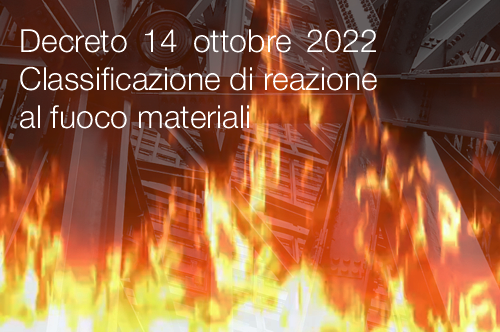Decreto 14 ottobre 2022

Decreto 14 ottobre 2022 / Classificazione di reazione al fuoco materiali
ID 17939 | 26.10.2022 / DM in allegato
Decreto Ministero dell'Interno 14 ottobre 2022 - Modifiche al decreto 26 giugno 1984, c...
ID 1418 | Update 26.11.2024
The risks associated with working at height requires all parties involved in loading, unloading, storage, cleaning, repair/maintenance and shipping/rail terminal operations to introduce safe systems of work, based on risk assessment and management.
These guidelines, which have been developed by industry experts, aim to promote best practice guidance for safe working at height in the entire chemicals supply chain.
There is a legal requirement for all participants in the supply chain to conduct risk assessments of their operations to eliminate or minimise risks, to protect employees and other personnel, and to co-operate and coordinate their activities See Directive 2001/45/EEC of the European Parliament and of the Council of 27 June 2001 amending Council Directive 89/655/EEC concerning the minimum safety and health requirements for the use of work equipment by workers at work (second individual Directive within the meaning of Article 16(1) of Directive 89/391/EEC).
As part of these overall obligations and measures taken to eliminate or minimise risk, a clear hierarchy of control should guide this process.
With regards to the number of serious incidents (see EU-OSHA statistics), personal injuries, and near-misses that are encountered in the logistics supply chain with various types of equipment and locations, the authors (ECTA/Cefic/Fecc) feel it is imperative to develop these working at height guidelines to assist in the overall reduction of falls from height that can cause death and injury.
Every working at height activity should be evaluated in detail. This will identify whether there are ways to avoid the working at height activity.
If working at height is unavoidable, the risk assessment will identify which infrastructure, equipment and/or procedure is the most suitable to carry out the work safely. In this regard, the hierarchy of control has been identified as the central guidance. In this context, the fact that the site management is legally responsible for providing a safe working environment for working at height should be taken into account.
____________
TABLE OF CONTENTS
DISCLAIMER
TABLE OF CONTENTS
INTRODUCTION
1. SCOPE AND OBJECTIVES
OBJECTIVES
SCOPE
2. RESPONSIBILITIES
2. 1 MANAGEMENT OF SITE
2.2 MANAGEMENT OF TRANSPORT COMPANY
2.3 SITE PERSONNEL
2.4 VEHICLE DRIVERS
3. LEGAL REQUIREMENTS
4. RISK ASSESSMENT AND MANAGEMENT
HIERARCHY OF CONTROL FOR ALL PRODUCT TYPES
NEAR MISS AND ACCIDENT/INCIDENT REPORTING
...
Fonte: CEFIC

ID 17939 | 26.10.2022 / DM in allegato
Decreto Ministero dell'Interno 14 ottobre 2022 - Modifiche al decreto 26 giugno 1984, c...
Oggetto: Fabbisogni per integratori a favore del personale operativo impegnato in particolari condizioni di lavoro per interventi di lunga du...
ID 18774 | 25.01.2023
Definizione degli standard formativi dell'apprendistato e criteri generali per la realizzazione dei percorsi di apprendistato, in attuazio...
Testata editoriale iscritta al n. 22/2024 del registro periodici della cancelleria del Tribunale di Perugia in data 19.11.2024